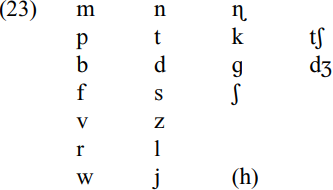

Grammar


Tenses


Present

Present Simple

Present Continuous

Present Perfect

Present Perfect Continuous


Past

Past Continuous

Past Perfect

Past Perfect Continuous

Past Simple


Future

Future Simple

Future Continuous

Future Perfect

Future Perfect Continuous

Passive and Active


Parts Of Speech


Nouns

Countable and uncountable nouns

Verbal nouns

Singular and Plural nouns

Proper nouns

Nouns gender

Nouns definition

Concrete nouns

Abstract nouns

Common nouns

Collective nouns

Definition Of Nouns


Verbs

Stative and dynamic verbs

Finite and nonfinite verbs

To be verbs

Transitive and intransitive verbs

Auxiliary verbs

Modal verbs

Regular and irregular verbs

Action verbs


Adverbs

Relative adverbs

Interrogative adverbs

Adverbs of time

Adverbs of place

Adverbs of reason

Adverbs of quantity

Adverbs of manner

Adverbs of frequency

Adverbs of affirmation


Adjectives

Quantitative adjective

Proper adjective

Possessive adjective

Numeral adjective

Interrogative adjective

Distributive adjective

Descriptive adjective

Demonstrative adjective


Pronouns

Subject pronoun

Relative pronoun

Reflexive pronoun

Reciprocal pronoun

Possessive pronoun

Personal pronoun

Interrogative pronoun

Indefinite pronoun

Emphatic pronoun

Distributive pronoun

Demonstrative pronoun


Pre Position


Preposition by function

Time preposition

Reason preposition

Possession preposition

Place preposition

Phrases preposition

Origin preposition

Measure preposition

Direction preposition

Contrast preposition

Agent preposition


Preposition by construction

Simple preposition

Phrase preposition

Double preposition

Compound preposition


Conjunctions

Subordinating conjunction

Correlative conjunction

Coordinating conjunction

Conjunctive adverbs


Interjections

Express calling interjection


Grammar Rules

Preference

Requests and offers

wishes

Be used to

Some and any

Could have done

Describing people

Giving advices

Possession

Comparative and superlative

Giving Reason

Making Suggestions

Apologizing

Forming questions

Since and for

Directions

Obligation

Adverbials

invitation

Articles

Imaginary condition

Zero conditional

First conditional

Second conditional

Third conditional

Reported speech


Linguistics

Phonetics

Phonology


Semantics


Pragmatics

Linguistics fields

Syntax

Morphology

Semantics

pragmatics

History

Writing

Grammar

Phonetics and Phonology

Semiotics


Reading Comprehension

Elementary

Intermediate

Advanced


Teaching Methods

Teaching Strategies
The consonant system Jamaican Creole The consonants
المؤلف:
Hubert Devonish and Otelemate G. Harry
المصدر:
A Handbook Of Varieties Of English Phonology
الجزء والصفحة:
465-27
2024-04-05
1220
The consonant system
Jamaican Creole
The consonants
The consonants
There are 21 phonemic consonants in JamC. These include the semi-vowels, /w/ [w] and /j/ [j], which are the phonetic vowels [i] and [u] functioning as consonants due to distributional constraints.
The palatal stops /kj/ [c], /gj/ [Ɉ] and /ny/ [ɲ] proposed by Cassidy and Le Page (1980) are not included in our inventory because we consider these phonetic palatals to be sequences of stops and the semi-vowels (cf. Devonish and Seiler 1991).

One feature little remarked on in the discussion of JamC consonant phonology over the years is the phonetics of the stop phonemes, /b/, /d/ and /g/. When these occur in the onset of a prominent syllable, they are phonetically realized as ingressive stops,  and [µ]. In other environments, notably in the coda or in the onset of a non-prominent syllable, the egressive [b], [d] and [g] allophones are employed. The distribution of these stops parallels that of the aspirated and unaspirated allophones of the voiceless stops, /p/, /t/ and /k/, with the aspirated allophones, [ph], [th] and [kh] occurring in the onset of prominent syllables, and the unaspirated ones, [p], [t] and [k], elsewhere.
and [µ]. In other environments, notably in the coda or in the onset of a non-prominent syllable, the egressive [b], [d] and [g] allophones are employed. The distribution of these stops parallels that of the aspirated and unaspirated allophones of the voiceless stops, /p/, /t/ and /k/, with the aspirated allophones, [ph], [th] and [kh] occurring in the onset of prominent syllables, and the unaspirated ones, [p], [t] and [k], elsewhere.
Wells (1973: 12) suggests that /h/ occurs contrastively in the Western varieties of JamC, notably those of Manchester, St. Elizabeth and Westmoreland. This is supported by the intuitions of JamC speakers from the entire range of western parishes. For such speakers, /h/ would serve to distinguish between the following pairs.
(24) a. /an/ ‘and’ /han/ ‘hand’
b. /iar/ ‘air’ /hiar/ ‘hair’
Such contrasts do not exist in the Eastern varieties of JamC, inclusive of that of Kingston. It is not, however, that the phone [h] does not exist in these varieties. Rather, it is employed for a different phonological function. Thus, the items above would, in the eastern varieties, be realized variably as [an] ~ [han] ‘and, hand’ and [iεɹ] ~ [hiεɹ] ‘air, hair’. In items without a lexically specified onset consonant, [h] may variably appear as a marker of emphasis, as an ‘[h]emphatic’ /h/. The phone [h], in the eastern varieties is simply marks off emphatic onsetless word initial syllables from their non-emphatic counterparts.
The consonant phoneme /ŋ/ has an unusual distribution in being the only one which is restricted to occurring in the coda.
 الاكثر قراءة في Phonology
الاكثر قراءة في Phonology
 اخر الاخبار
اخر الاخبار
اخبار العتبة العباسية المقدسة

الآخبار الصحية















 (نوافذ).. إصدار أدبي يوثق القصص الفائزة في مسابقة الإمام العسكري (عليه السلام)
(نوافذ).. إصدار أدبي يوثق القصص الفائزة في مسابقة الإمام العسكري (عليه السلام) قسم الشؤون الفكرية يصدر مجموعة قصصية بعنوان (قلوب بلا مأوى)
قسم الشؤون الفكرية يصدر مجموعة قصصية بعنوان (قلوب بلا مأوى) قسم الشؤون الفكرية يصدر مجموعة قصصية بعنوان (قلوب بلا مأوى)
قسم الشؤون الفكرية يصدر مجموعة قصصية بعنوان (قلوب بلا مأوى)


















